Popular varieties and hybrids of purple carrots
Purple (lilac, blue) carrots surprise not only with their color, but also with useful properties: they contain many vitamins and trace elements, are used as a medicine, and help with weight loss. Today you will learn about the advantages and disadvantages of purple carrots, get acquainted with popular varieties, the peculiarities of growing and storing an unusual crop.
The content of the article
Description of purple carrots
Purple carrots are attractive in appearance, but are valued for their rich chemical composition and beneficial properties.
Appearance and taste
The purple carrot belongs to the Umbrella family. The vegetable has green foliage with feathery leaves and a strong root crop in the shape of an elongated and pointed cone. Its color is represented by many shades of purple. Most varieties have an orange core. The size of the root crop is 20 to 30 cm in length and 2-3 cm in diameter.
The taste is unusual, sweet, slightly spicy, with a piney rosemary flavor. The pulp is juicy.
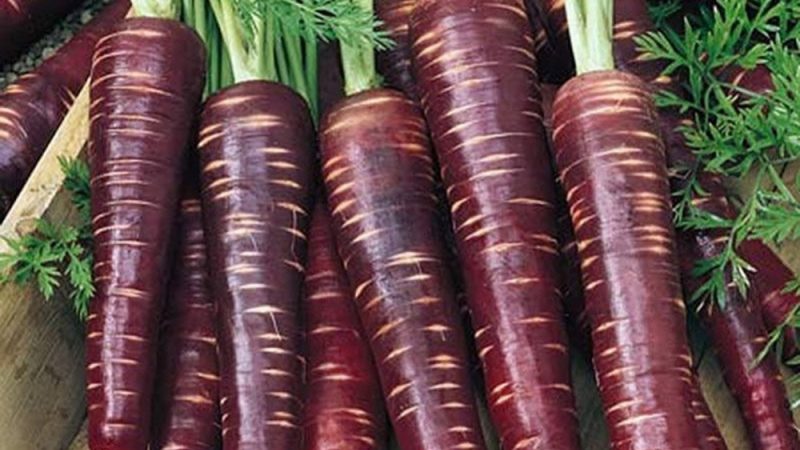
Origin and development
Until the 16th century, common carrots were purple in color. The orange one we are used to is the result of the work of Dutch breeders. By growing purple carrots, we return to their original appearance.
Chemical composition, trace elements and vitamins, useful properties
Purple carrots are packed with vitamins and minerals. 100 g of vegetable contains:
- potassium - 200 mg;
- vanadium - 99 mg;
- chlorine - 63 mg;
- phosphorus - 55 mg;
- magnesium - 38 mg;
- calcium - 27 mg;
- sodium - 21 mg;
- sulfur - 6 mg;
- copper - 80 mcg;
- fluorine - 55 mcg;
- molybdenum - 20 mcg;
- nickel - 6 mcg;
- lithium - 6 mcg.
Carrots contain vitamins A, B, C, E, beta-carotene. It is also characterized by a high content of anthocyanins - plant pigments that cause the purple hue of the root crop. The body does not produce them on its own.
Due to the presence of these nutrients, regular consumption of the purple vegetable contributes to:
- strengthening immunity;
- strengthening the cardiovascular and nervous systems;
- improving metabolism;
- normalization of blood pressure;
- strengthening of vision;
- decrease in blood sugar and cholesterol levels;
- improving the condition of hair, nails and skin.
Purple carrots are used in weight loss diets. It contains few calories and a lot of fiber, saturates well, improves digestion, promotes the absorption of nutrients.
Application features
In cooking, purple carrots are used in the same way as orange ones: they are stewed, fried, boiled, baked, steamed, added to soups, sauces, gravies, used in salads, made juices and marinades. The plant is combined with various products - other vegetables, cereals, meat. The vegetable is often used to decorate dishes. Purple carrot food is delicious, healthy and easy to digest.
Ripening period
Purple carrot varieties are classified by ripening time:
- the early ones ripen 65-80 days after germination;
- mid-season - with a growing season of 100-110 days;
- late - ripening period is from 120 to 140 days.
Yield
High seed germination does not affect yield purple carrots. The yield is lower compared to the orange varieties.
Disease resistance
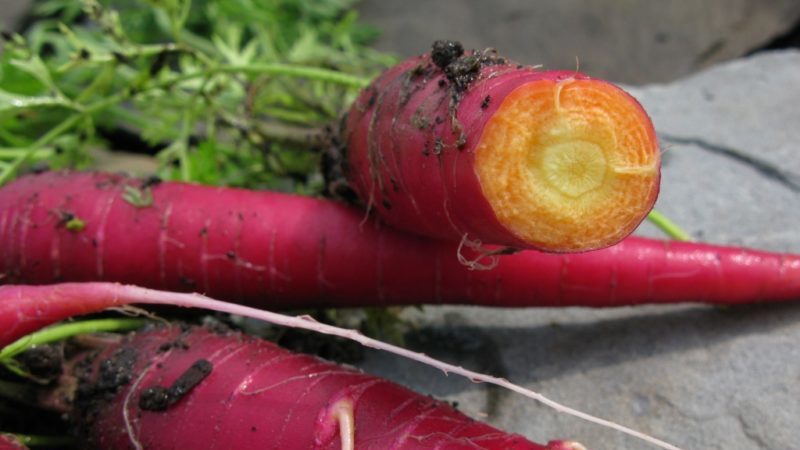
Purple carrots are highly resistant to diseases, but they are susceptible to bacteriosis, phomosis, septoria, brown spot, black, red, gray and white rot.
To prevent the development of diseases, seeds and soil are disinfected before planting. The tops of adult plants are sprayed with fungicides.
Also, insect pests are dangerous for the vegetable: slugs, winter scoops, carrot flies and wireworms. In the fight against them, soil treatment with chemical agents in the spring helps.
Growing regions and climate requirements
Purple carrots are grown in all regions of Russia. Some varieties are not suitable for growing in southern regions with hot summers, because at elevated temperatures they slow down development.
Comfortable temperature for growth - + 20 ... + 23 ° C. Shading is required when elevated. Most varieties are tolerant to the cold, tolerates temperatures as low as -4 ° C.
Popular varieties and hybrids
Popular varieties and hybrids of purple carrots are presented below:
- Dragon. An early ripe variety with a vegetation period of 85-90 days. Outside, the root crop is bright purple, inside is orange. Its length is up to 25 cm, diameter is within 3 cm. After heat treatment, carrots retain their spicy aroma and taste. Productivity - 5-7 kg per 1 sq. m. Dragon is adapted to cold climates and unsuitable for long-term storage.
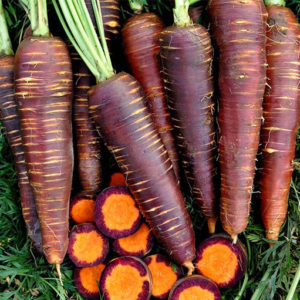
- Cosmic Purple. A variety with an early ripening period - 60 days. Outside, the root vegetable is a raspberry-purple hue, inside is completely orange. Length - within 20 cm. Carrots taste sweet, crunchy. Productivity - 5-8 kg per 1 sq. m. The variety is more often used fresh, since during heat treatment it loses its useful qualities and attractive appearance.
- Purple haze. An early ripening variety that ripens 70 days after sowing. For winter storage, the crop is harvested after 100 days. The hybrid is characterized by a dark purple color on the outside and orange on the inside. The length of the root crop varies from 15 to 30 cm, the diameter is up to 5 cm, the average weight is 180 g. The yield is 5 kg per square meter. m.
- Purple. The growing season is from 90 days. Root length - about 25 cm, diameter - 4-5 cm, weight - up to 180 g. It does not lose color during heat treatment. Productivity - up to 7 kg per 1 sq. m. Despite early ripening, purple carrots are suitable for long-term storage.
- Purple dragon... Outside, the root crop is violet-red, inside is orange-yellow. Fruit length - up to 25 cm, diameter - 3 cm. The variety is recommended for use as a seasoning. Also added to salads when canning. Productivity - 4 kg per 1 sq. m.
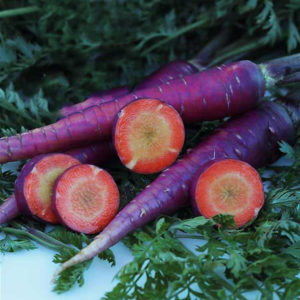
- The queen is purple. A hybrid with a late ripening period - 140 days. Vegetables begin to be eaten after 110 days. Outside is purple, inside is orange. The length of the root crop is about 20 cm, the diameter is 5 cm, the weight is on average 200 g. The yield is about 5.5 kg per square meter. m.
- Purple caramel. Late-ripening variety - the growing season takes 140 days. A root crop with purple pulp and orange core grows on average up to 17 cm, diameter - about 5 cm, weight - up to 200 g. Productivity - 5-6 kg per 1 sq. m. Purple carrots Caramel is suitable for winter storage.
- Chocolate bunny F1... An early ripe hybrid. The growing season is 60 days after germination. Outside, the root vegetable is grayish, the pulp is purple or burgundy, the core is bright orange. Fruit length - up to 30 cm, average weight is 180 g. Productivity - about 5 kg per 1 sq. M. m. Carrot Chocolate bunny is recommended to be consumed fresh.
The advantages and disadvantages of purple varieties
Purple carrots have significant benefits and minor disadvantages.
Advantages:
- ease of growing and unpretentious care;
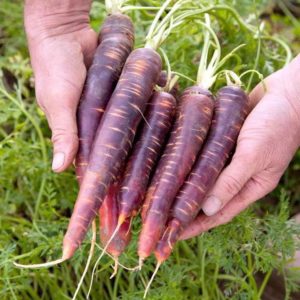
- high content of vitamins and minerals;
- long shelf life;
- medicinal properties;
- resistance to diseases and pests;
- high germination of seeds.
Disadvantages:
- upon contact, the root vegetable stains in purple tones;
- when heat treated, it fades, acquiring a brown color.
Difference from other varieties
Purple carrots contain more nutrients than other varieties, including carotene, anthocyanins, and antioxidants. Seeds such carrots are highly germinating. But the yield is lower in comparison with other varieties. Also, the difference is the taste of the variety: sweetness, juiciness and the presence of spicy notes.
Features of planting and growing
Planting carrots begins with preparing the seeds. To speed up the emergence of seed, seed soaking, heat treatment, bubbling and burying are used.
Attention! Seeds are sown in open ground in early spring, when the topsoil warms up to + 5 ° C.
Landing features:
- if the soil is light, the seeds are sown to a depth of 20-30 mm, if heavy - 15-20 mm;
- row spacing - approximately 20 cm;
- the gap between the seeds in a row is about 2 cm.
Growing carrot care includes:
- Loosening the soil... Purple carrots need this procedure regularly, starting with the first pecking of the first shoots. They loosen the soil after rain.
- Fertilization. It is enough to make 2 additional feeding per season. It is recommended to apply liquid fertilizers from nettle, manure and compost every month.
- Thinning of seedlings. The first procedure is carried out when 1-2 leaves are formed. Large shoots are left at a distance of 2 cm from each other. The procedure is repeated when 2 pairs of leaves are formed on the bushes, the distance between the seedlings is increased to 4 cm.
- Watering. The first time the carrots are watered every other day. After the number of waterings is reduced to 1 time per week, the ridges are abundantly shed.
- Weeding. Weeds are removed manually as they emerge.
- Mulching. The procedure is started when the tops grow to 10-15 cm. Finely chopped grass is used as mulch. The procedure is repeated after 2-3 weeks. This reduces the number of weeds and improves the quality of the root crops.
Differences in cultivation compared to conventional species
Purple carrots have a better germination rate than regular carrots, so the seeds are sown at a distance from each other. After germination, the plantings are thinned out so that the roots can develop freely.
Features of harvesting and storing crops
The timing of harvesting purple carrots depends on the variety selected. Most fit for long-term storage and has good keeping quality.
How and when to collect
Harvesting falls in late June - early September. Do this in dry, sunny weather. Root crops are pulled out by hand or dug out with a shovel, cleaned of earth clods and dried. Drying takes about a week.
Storage features and keeping quality of the variety
A basement or cellar is suitable for storing purple carrots, that is, a dark room with a temperature in the range of 0 ... + 6 ° C and a humidity of 70%. Dry vegetables are put in plastic or wooden boxes, sprinkled with sand, moss or sawdust so that the roots do not come into contact with each other.
There is another way for winter storage. It consists in glazing vegetables with clay. It is diluted in water to a creamy consistency, each fruit is in turn dipped in the mixture and dried. Dried carrots are stored until the next season without losing their beneficial properties.
Reviews
Gardeners appreciate varieties of purple carrots for their taste, beneficial properties, and unpretentious care.
Marina: “I bought purple carrot seeds out of interest in the store. For the experiment, I planted three rows. All the seeds have sprung up. She looked after ordinary carrots. Next season I will plant more, I really liked the taste of carrots. "
Svetlana Igorevna: “I am aware of the medicinal properties of purple carrots and have been growing this variety in the country for several years.Purple carrots keep well, so they are a frequent guest on the table. I especially love fresh carrots, I make juice for my grandchildren.
Conclusion
Purple is a natural color for carrots, indicating the presence of large quantities of anthocyanins in the vegetable. Lilac carrots have great nutritional value and medicinal properties. At the same time, it is unpretentious in care and easy to grow.